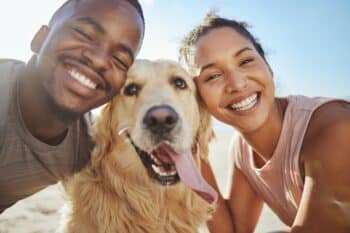Shutterstock
Dogs, like humans, can suffer from anxiety caused by a variety of triggers, whether it’s loud noises, separation, or changes in their routine. As pet owners, it’s essential to recognize the signs of anxiety and take proactive steps to help alleviate it. With the right approach, you can provide your dog with comfort and security, reducing their stress and making them feel more at ease. The following tips offer simple and effective ways to ease your dog’s anxiety, fostering a peaceful and harmonious environment for both you and your pet.
Provide a Safe, Quiet Space
Shutterstock
Creating a designated safe space for your dog can be incredibly helpful in managing their anxiety. This space should be quiet and free from disturbances, allowing your dog to retreat when they need to feel safe. You can use a crate, a quiet room, or a designated corner in the house. Adding their favorite blanket or toy will make it even more comforting. Having a place to escape to provides your dog with a sense of security when they’re feeling overwhelmed.
Keep a Consistent Routine
Shutterstock
Dogs thrive on routine, and providing a consistent daily schedule can help alleviate anxiety. A predictable routine, including regular feeding times, walks, and play sessions, helps your dog feel more secure. When your dog knows what to expect throughout the day, it reduces their stress and gives them a sense of stability. Whether it’s a set time for meals or consistent bedtime rituals, the more predictable the environment, the less anxious your dog will be.
Use Calming Products
Shutterstock
There are several calming products available that can help reduce your dog’s anxiety. Products such as pheromone diffusers, calming collars, or sprays mimic natural dog pheromones that have a soothing effect. These can help ease your dog’s nervousness during stressful situations like thunderstorms or car rides. Other options, like calming music or pressure wraps, such as the Thundershirt, can also provide comfort. Experimenting with different products will allow you to find the right solution for your dog’s specific needs.
Offer Mental Stimulation and Exercise
Shutterstock
Exercise and mental stimulation are essential in reducing anxiety in dogs. Physical activity helps burn off excess energy, which can contribute to stress and nervousness. Daily walks, playtime, or agility exercises help tire your dog out and promote relaxation. Mental stimulation through puzzle toys or learning new tricks can also keep your dog’s mind occupied, offering a healthy distraction from anxiety. A tired and mentally engaged dog is much less likely to experience anxious behaviors.
Try Positive Reinforcement Training
Shutterstock
Positive reinforcement training helps your dog build confidence and reduces anxiety by rewarding desired behaviors with treats, praise, and affection. This method creates a positive association with calmness and obedience, which helps reduce stress. By focusing on rewarding good behavior, your dog learns that being calm and relaxed leads to positive outcomes. Positive reinforcement can also help your dog feel more secure, as they gain confidence in their ability to behave in a stress-free manner.
Desensitize Your Dog to Stressful Triggers
Shutterstock
Desensitization involves exposing your dog to anxiety-inducing situations in a controlled manner, gradually increasing the exposure over time. For instance, if your dog is afraid of loud noises, you can start by playing recorded sounds at a low volume and rewarding calm behavior. Slowly increase the volume as your dog becomes more accustomed to the noise, allowing them to desensitize and reduce their fear. This method teaches your dog to associate previously frightening triggers with positive experiences, helping them stay calm in stressful situations.
Be Calm and Patient
Shutterstock
Dogs are highly sensitive to their owner’s emotions, so remaining calm and patient is crucial when your dog is feeling anxious. If you’re stressed or anxious, your dog will likely pick up on those emotions and become even more anxious. Staying calm and patient when your dog is stressed helps them feel reassured and safe. Avoid punishing anxious behaviors, as this can create more fear and anxiety. Instead, offer gentle reassurance and comfort, allowing your dog to feel confident in your presence.
Provide Comforting Touch
Shutterstock
Comforting touch can be incredibly soothing for anxious dogs. Gentle petting, massages, or simply sitting close to your dog can help calm their nerves. Some dogs find physical contact especially comforting when they’re feeling nervous or scared. Massaging areas like the neck, shoulders, or back can help release tension and promote relaxation. Be mindful of your dog’s body language, as some dogs may prefer more subtle interactions, while others might enjoy being held or cuddled when they’re anxious.
Create a Relaxing Environment
Shutterstock
Your home environment plays a huge role in your dog’s anxiety levels. Reducing loud noises and creating a calming atmosphere can significantly help your dog feel at ease. Dim lighting, relaxing music, and calming scents like lavender or chamomile can contribute to a soothing environment. Ensuring that your dog has access to their safe space allows them to retreat when necessary. By minimizing distractions and stressors in their environment, you create a peaceful space where your dog can relax and unwind.
The Magic of Patience, Love, and Treats!
Shutterstock
Helping your dog manage anxiety requires patience, understanding, and lots of love. Each dog is different, so finding the right methods to reduce their stress may take time. Consistency is essential—whether it’s creating a safe space, sticking to a routine, or using calming products, repetition will help your dog feel secure. Most importantly, show your dog love and affection. With time and positive reinforcement, your dog will feel more at ease and learn to manage anxiety in a healthier, more balanced way.
The post 9 Simple Tricks To Help Your Dog Feel Less Anxious appeared first on iHeartDogs.com.

